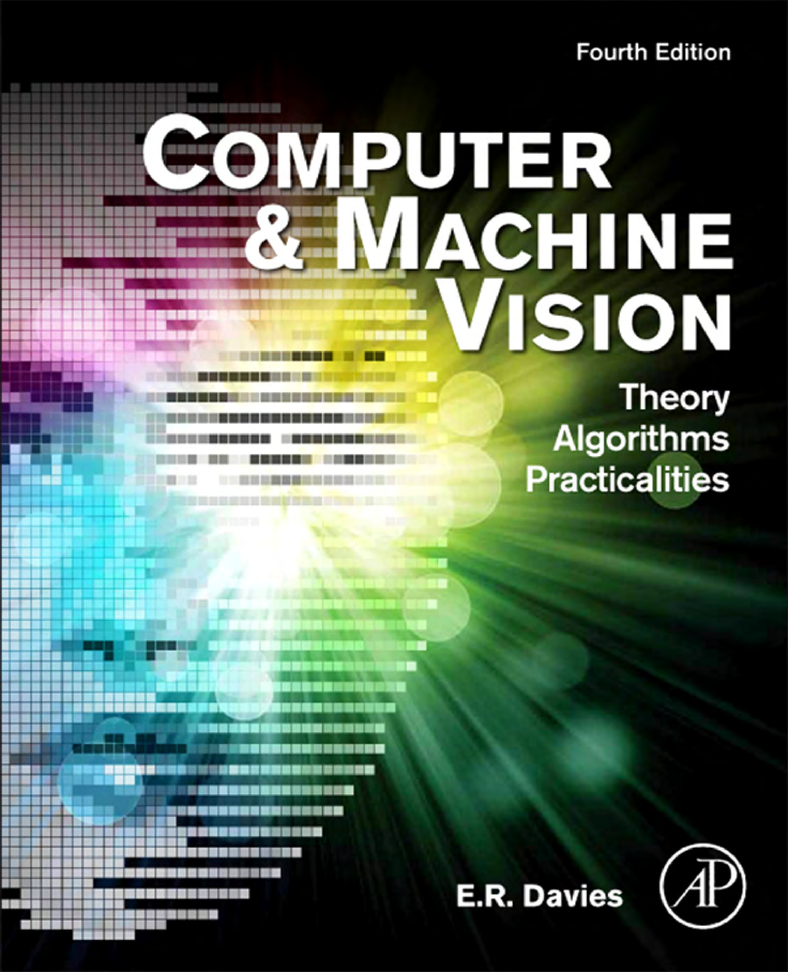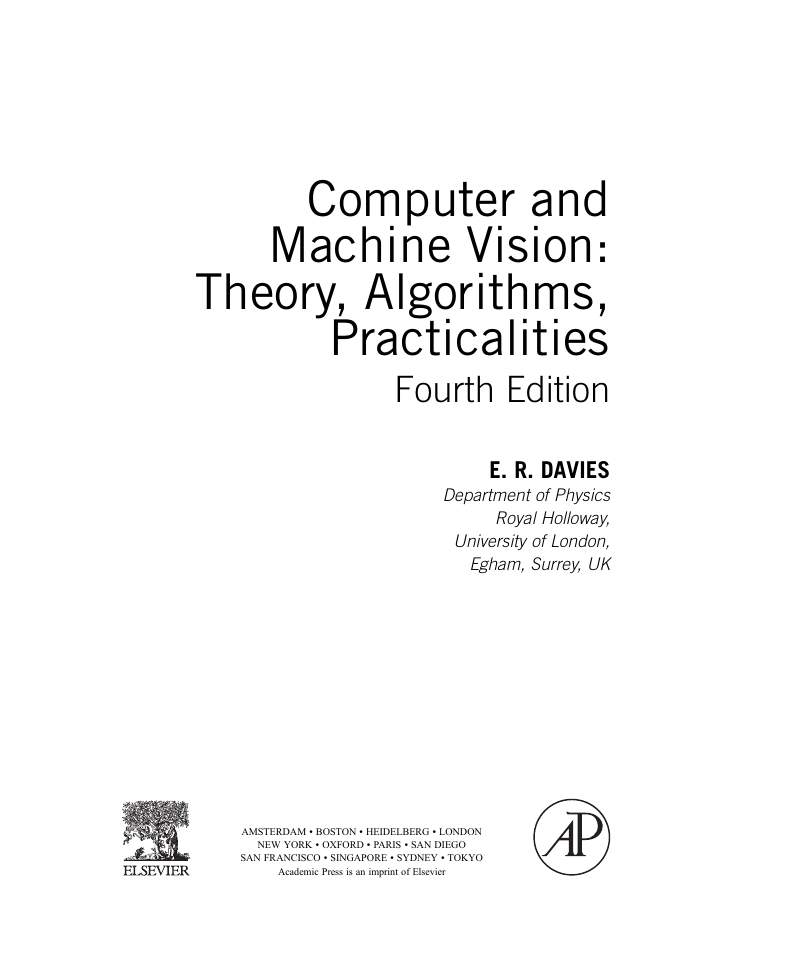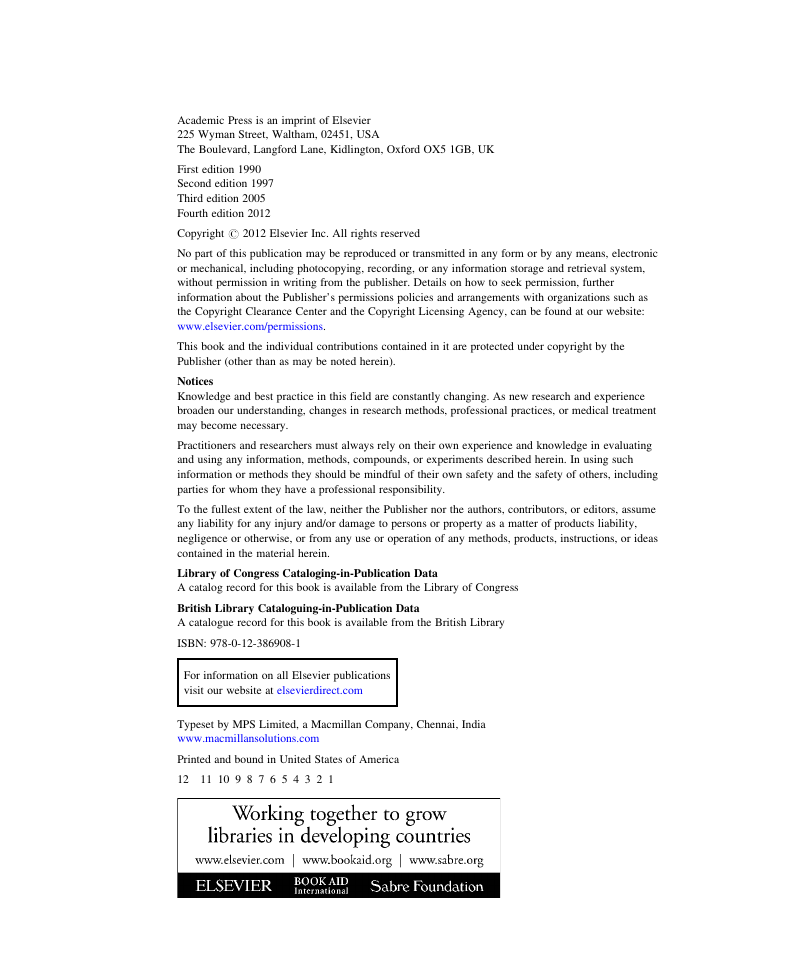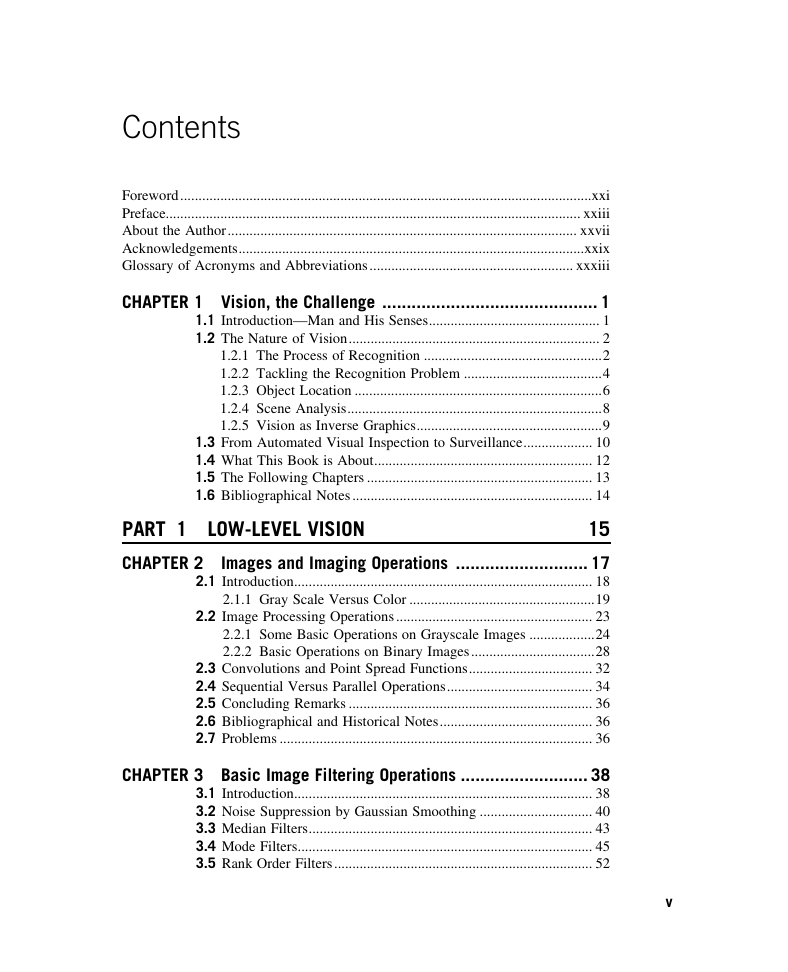Front Cover
Computer and Machine Vision: Theory, Algorithms, Practicalities
Copyright Page
Contents
Foreword
Preface
About the Author
Acknowledgements
Glossary of Acronyms and Abbreviations
1. Vision, the Challenge
1.1 Introduction—Man and His Senses
1.2 The Nature of Vision
1.2.1 The Process of Recognition
1.2.2 Tackling the Recognition Problem
1.2.3 Object Location
1.2.4 Scene Analysis
1.2.5 Vision as Inverse Graphics
1.3 From Automated Visual Inspection to Surveillance
1.4 What This Book is About
1.5 The Following Chapters
1.6 Bibliographical Notes
1. Low-Level Vision
2 Images and Imaging Operations
2.1 Introduction
2.1.1 Gray Scale Versus Color
2.2 Image Processing Operations
2.2.1 Some Basic Operations on Grayscale Images
2.2.2 Basic Operations on Binary Images
2.3 Convolutions and Point Spread Functions
2.4 Sequential Versus Parallel Operations
2.5 Concluding Remarks
2.6 Bibliographical and Historical Notes
2.7 Problems
3 Basic Image Filtering Operations
3.1 Introduction
3.2 Noise Suppression by Gaussian Smoothing
3.3 Median Filters
3.4 Mode Filters
3.5 Rank Order Filters
3.6 Reducing Computational Load
3.7 Sharp–Unsharp Masking
3.8 Shifts Introduced by Median Filters
3.8.1 Continuum Model of Median Shifts
3.8.2 Generalization to Grayscale Images
3.8.3 Problems with Statistics
3.9 Discrete Model of Median Shifts
3.10 Shifts Introduced by Mode Filters
3.11 Shifts Introduced by Mean and Gaussian Filters
3.12 Shifts Introduced by Rank Order Filters
3.12.1 Shifts in Rectangular Neighborhoods
3.13 The Role of Filters in Industrial Applications of Vision
3.14 Color in Image Filtering
3.15 Concluding Remarks
3.16 Bibliographical and Historical Notes
3.16.1 More Recent Developments
3.17 Problems
4 Thresholding Techniques
4.1 Introduction
4.2 Region-Growing Methods
4.3 Thresholding
4.3.1 Finding a Suitable Threshold
4.3.2 Tackling the Problem of Bias in Threshold Selection
4.3.2.1 Methods Based on Finding a Valley in the Intensity Distribution
4.3.3 Summary
4.4 Adaptive Thresholding
4.4.1 The Chow and Kaneko Approach
4.4.2 Local Thresholding Methods
4.5 More Thoroughgoing Approaches to Threshold Selection
4.5.1 Variance-Based Thresholding
4.5.2 Entropy-Based Thresholding
4.5.3 Maximum Likelihood Thresholding
4.6 The Global Valley Approach to Thresholding
4.7 Practical Results Obtained Using the Global Valley Method
4.8 Histogram Concavity Analysis
4.9 Concluding Remarks
4.10 Bibliographical and Historical Notes
4.10.1 More Recent Developments
4.11 Problems
5 Edge Detection
5.1 Introduction
5.2 Basic Theory of Edge Detection
5.3 The Template Matching Approach
5.4 Theory of 3×3 Template Operators
5.5 The Design of Differential Gradient Operators
5.6 The Concept of a Circular Operators
5.7 Detailed Implementation of Circular Operators
5.8 The Systematic Design of Differential Edge Operators
5.9 Problems with the Above Approach—Some Alternative Schemes
5.10 Hysteresis Thresholding
5.11 The Canny Operator
5.12 The Laplacian Operator
5.13 Active Contours
5.14 Practical Results Obtained Using Active Contours
5.15 The Level Set Approach to Object Segmentation
5.16 The Graph Cut Approach to Object Segmentation
5.17 Concluding Remarks
5.18 Bibliographical and Historical Notes
5.18.1 More Recent Developments
5.19 Problems
6 Corner and Interest Point Detection
6.1 Introduction
6.2 Template Matching
6.3 Second-Order Derivative Schemes
6.4 A Median Filter-Based Corner Detector
6.4.1 Analyzing the Operation of the Median Detector
6.4.2 Practical Results
6.5 The Harris Interest Point Operator
6.5.1 Corner Signals and Shifts for Various Geometric Configurations
6.5.2 Performance with Crossing Points and Junctions
6.5.3 Different Forms of the Harris Operator
6.6 Corner Orientation
6.7 Local Invariant Feature Detectors and Descriptors
6.7.1 Harris Scale and Affine-Invariant Detectors and Descriptors
6.7.2 Hessian Scale and Affine-Invariant Detectors and Descriptors
6.7.3 The SIFT Operator
6.7.4 The SURF Operator
6.7.5 Maximally Stable Extremal Regions
6.7.6 Comparison of the Various Invariant Feature Detectors
6.8 Concluding Remarks
6.9 Bibliographical and Historical Notes
6.9.1 More Recent Developments
6.10 Problems
7 Mathematical Morphology
7.1 Introduction
7.2 Dilation and Erosion in Binary Images
7.2.1 Dilation and Erosion
7.2.2 Cancellation Effects
7.2.3 Modified Dilation and Erosion Operators
7.3 Mathematical Morphology
7.3.1 Generalized Morphological Dilation
7.3.2 Generalized Morphological Erosion
7.3.3 Duality Between Dilation and Erosion
7.3.4 Properties of Dilation and Erosion Operators
7.3.5 Closing and Opening
7.3.6 Summary of Basic Morphological Operations
7.4 Grayscale Processing
7.4.1 Morphological Edge Enhancement
7.4.2 Further Remarks on the Generalization to Grayscale Processing
7.5 Effect of Noise on Morphological Grouping Operations
7.5.1 Detailed Analysis
7.5.2 Discussion
7.6 Concluding Remarks
7.7 Bibliographical and Historical Notes
7.7.1 More Recent Developments
7.8 Problem
8 Texture
8.1 Introduction
8.2 Some Basic Approaches to Texture Analysis
8.3 Graylevel Co-occurrence Matrices
8.4 Laws’ Texture Energy Approach
8.5 Ade’s Eigenfilter Approach
8.6 Appraisal of the Laws and Ade Approaches
8.7 Concluding Remarks
8.8 Bibliographical and Historical Notes
8.8.1 More Recent Developments
2. Intermediate-Level Vision
9 Binary Shape Analysis
9.1 Introduction
9.2 Connectedness in Binary Images
9.3 Object Labeling and Counting
9.3.1 Solving the Labeling Problem in a More Complex Case
9.4 Size Filtering
9.5 Distance Functions and Their Uses
9.5.1 Local Maxima and Data Compression
9.6 Skeletons and Thinning
9.6.1 Crossing Number
9.6.2 Parallel and Sequential Implementations of Thinning
9.6.3 Guided Thinning
9.6.4 A Comment on the Nature of the Skeleton
9.6.5 Skeleton Node Analysis
9.6.6 Application of Skeletons for Shape Recognition
9.7 Other Measures for Shape Recognition
9.8 Boundary Tracking Procedures
9.9 Concluding Remarks
9.10 Bibliographical and Historical Notes
9.10.1 More Recent Developments
9.11 Problems
10 Boundary Pattern Analysis
10.1 Introduction
10.2 Boundary Tracking Procedures
10.3 Centroidal Profiles
10.4 Problems with the Centroidal Profile Approach
10.4.1 Some Solutions
10.5 The (s, ψ) Plot
10.6 Tackling the Problems of Occlusion
10.7 Accuracy of Boundary Length Measures
10.8 Concluding Remarks
10.9 Bibliographical and Historical Notes
10.9.1 More Recent Developments
10.10 Problems
11 Line Detection
11.1 Introduction
11.2 Application of the Hough Transform to Line Detection
11.3 The Foot-of-Normal Method
11.3.1 Application of the Foot-of-Normal Method
11.4 Longitudinal Line Localization
11.5 Final Line Fitting
11.6 Using RANSAC for Straight Line Detection
11.7 Location of Laparoscopic Tools
11.8 Concluding Remarks
11.9 Bibliographical and Historical Notes
11.9.1 More Recent Developments
11.10 Problems
12 Circle and Ellipse Detection
12.1 Introduction
12.2 Hough-Based Schemes for Circular Object Detection
12.3 The Problem of Unknown Circle Radius
12.3.1 Some Practical Results
12.4 The Problem of Accurate Center Location
12.4.1 A Solution Requiring Minimal Computation
12.5 Overcoming the Speed Problem
12.5.1 More Detailed Estimates of Speed
12.5.2 Robustness
12.5.3 Practical Results
12.5.4 Summary
12.6 Ellipse Detection
12.6.1 The Diameter Bisection Method
12.6.2 The Chord–Tangent Method
12.6.3 Finding the Remaining Ellipse Parameters
12.7 Human Iris Location
12.8 Hole Detection
12.9 Concluding Remarks
12.10 Bibliographical and Historical Notes
12.10.1 More Recent Developments
12.11 Problems
13 The Hough Transform and Its Nature
13.1 Introduction
13.2 The Generalized Hough Transform
13.3 Setting Up the Generalized Hough Transform—Some Relevant Questions
13.4 Spatial Matched Filtering in Images
13.5 From Spatial Matched Filters to Generalized Hough Transforms
13.6 Gradient Weighting Versus Uniform Weighting
13.6.1 Calculation of Sensitivity and Computational Load
13.7 Summary
13.8 Use of the GHT for Ellipse Detection
13.8.1 Practical Details
13.9 Comparing the Various Methods
13.10 Fast Implementations of the Hough Transform
13.11 The Approach of Gerig and Klein
13.12 Concluding Remarks
13.13 Bibliographical and Historical Notes
13.13.1 More Recent Developments
13.14 Problems
14 Pattern Matching Techniques
14.1 Introduction
14.2 A Graph-Theoretic Approach to Object Location
14.2.1 A Practical Example—Locating Cream Biscuits
14.3 Possibilities for Saving Computation
14.4 Using the Generalized Hough Transform for Feature Collation
14.4.1 Computational Load
14.5 Generalizing the Maximal Clique and Other Approaches
14.6 Relational Descriptors
14.7 Search
14.8 Concluding Remarks
14.9 Bibliographical and Historical Notes
14.9.1 More Recent Developments
14.10 Problems
3. 3-D Vision and Motion
15 The Three-Dimensional World
15.1 Introduction
15.2 3-D Vision—the Variety of Methods
15.3 Projection Schemes for Three-Dimensional Vision
15.3.1 Binocular Images
15.3.2 The Correspondence Problem
15.4 Shape from Shading
15.5 Photometric Stereo
15.6 The Assumption of Surface Smoothness
15.7 Shape from Texture
15.8 Use of Structured Lighting
15.9 Three-Dimensional Object Recognition Schemes
15.10 Horaud’s Junction Orientation Technique
15.11 An Important Paradigm—Location of Industrial Parts
15.12 Concluding Remarks
15.13 Bibliographical and Historical Notes
15.13.1 More Recent Developments
15.14 Problems
16 Tackling the Perspective n-point Problem
16.1 Introduction
16.2 The Phenomenon of Perspective Inversion
16.3 Ambiguity of Pose under Weak Perspective Projection
16.4 Obtaining Unique Solutions to the Pose Problem
16.4.1 Solution of the Three-Point Problem
16.4.2 Using Symmetric Trapezia for Estimating Pose
16.5 Concluding Remarks
16.6 Bibliographical and Historical Notes
16.6.1 More Recent Developments
16.7 Problems
17 Invariants and Perspective
17.1 Introduction
17.2 Cross-ratios: the “Ratio of Ratios” Concept
17.3 Invariants for Noncollinear Points
17.3.1 Further Remarks About the Five-Point Configuration
17.4 Invariants for Points on Conics
17.5 Differential and Semi-differential Invariants
17.6 Symmetric Cross-ratio Functions
17.7 Vanishing Point Detection
17.8 More on Vanishing Points
17.9 Apparent Centers of Circles and Ellipses
17.10 The Route to Face Recognition
17.10.1 The Face as Part of a 3-D Object
17.11 Perspective Effects in Art and Photography
17.12 Concluding Remarks
17.13 Bibliographical and Historical Notes
17.13.1 More Recent Developments
17.14 Problems
18 Image Transformations and Camera Calibration
18.1 Introduction
18.2 Image Transformations
18.3 Camera Calibration
18.4 Intrinsic and Extrinsic Parameters
18.5 Correcting for Radial Distortions
18.6 Multiple View Vision
18.7 Generalized Epipolar Geometry
18.8 The Essential Matrix
18.9 The Fundamental Matrix
18.10 Properties of the Essential and Fundamental Matrices
18.11 Estimating the Fundamental Matrix
18.12 An Update on the Eight-Point Algorithm
18.13 Image Rectification
18.14 3-D Reconstruction
18.15 Concluding Remarks
18.16 Bibliographical and Historical Notes
18.16.1 More Recent Developments
18.17 Problems
19 Motion
19.1 Introduction
19.2 Optical Flow
19.3 Interpretation of Optical Flow Fields
19.4 Using Focus of Expansion to Avoid Collision
19.5 Time-to-Adjacency Analysis
19.6 Basic Difficulties with the Optical Flow Model
19.7 Stereo from Motion
19.8 The Kalman Filter
19.9 Wide Baseline Matching
19.10 Concluding Remarks
19.11 Bibliographical and Historical Notes
19.12 Problem
4. Toward Real-Time Pattern Recognition Systems
20 Automated Visual Inspection
20.1 Introduction
20.2 The Process of Inspection
20.3 The Types of Object to be Inspected
20.3.1 Food Products
20.3.2 Precision Components
20.3.3 Differing Requirements for Size Measurement
20.3.4 Three-Dimensional Objects
20.3.5 Other Products and Materials for Inspection
20.4 Summary: The Main Categories of Inspection
20.5 Shape Deviations Relative to a Standard Template
20.6 Inspection of Circular Products
20.7 Inspection of Printed Circuits
20.8 Steel Strip and Wood Inspection
20.9 Inspection of Products with High Levels of Variability
20.10 X-Ray Inspection
20.10.1 The Dual-Energy Approach to X-Ray Inspection
20.11 The Importance of Color in Inspection
20.12 Bringing Inspection to the Factory
20.13 Concluding Remarks
20.14 Bibliographical and Historical Notes
20.14.1 More Recent Developments
21 Inspection of Cereal Grains
21.1 Introduction
21.2 Case Study: Location of Dark Contaminants in Cereals
21.2.1 Application of Morphological and Nonlinear Filters to Locate Rodent Droppings
21.2.2 Problems with Closing
21.2.3 Ergot Detection Using the Global Valley Method
21.3 Case Study: Location of Insects
21.3.1 The Vectorial Strategy for Linear Feature Detection
21.3.2 Designing Linear Feature Detection Masks for Larger Windows
21.3.3 Application to Cereal Inspection
21.3.4 Experimental Results
21.4 Case Study: High-Speed Grain Location
21.4.1 Extending an Earlier Sampling Approach
21.4.2 Application to Grain Inspection
21.4.3 Summary
21.5 Optimizing the Output for Sets of Directional Template Masks
21.5.1 Application of the Formulae
21.5.2 Discussion
21.6 Concluding Remarks
21.7 Bibliographical and Historical Notes
21.7.1 More Recent Developments
22 Surveillance
22.1 Introduction
22.2 Surveillance—The Basic Geometry
22.3 Foreground–Background Separation
22.3.1 Background Modeling
22.3.2 Practical Examples of Background Modeling
22.3.3 Direct Detection of the Foreground
22.4 Particle Filters
22.5 Use of Color Histograms for Tracking
22.6 Implementation of Particle Filters
22.7 Chamfer Matching, Tracking, and Occlusion
22.8 Combining Views from Multiple Cameras
22.8.1 The Case of Nonoverlapping Fields of View
22.9 Applications to the Monitoring of Traffic Flow
22.9.1 The System of Bascle et al.
22.9.2 The System of Koller et al.
22.10 License Plate Location
22.11 Occlusion Classification for Tracking
22.12 Distinguishing Pedestrians by Their Gait
22.13 Human Gait Analysis
22.14 Model-Based Tracking of Animals
22.15 Concluding Remarks
22.16 Bibliographical and Historical Notes
22.16.1 More Recent Developments
22.17 Problem
23 In-Vehicle Vision Systems
23.1 Introduction
23.2 Locating the Roadway
23.3 Location of Road Markings
23.4 Location of Road Signs
23.5 Location of Vehicles
23.6 Information Obtained by Viewing Licence Plates and Other Structural Features
23.7 Locating Pedestrians
23.8 Guidance and Egomotion
23.8.1 A Simple Path Planning Algorithm
23.9 Vehicle Guidance in Agriculture
23.9.1 3-D Aspects of the Task
23.9.2 Real-Time Implementation
23.10 Concluding Remarks
23.11 More Detailed Developments and Bibliographies Relating to Advanced Driver Assistance Systems
23.11.1 Developments in Vehicle Detection
23.11.2 Developments in Pedestrian Detection
23.11.3 Developments in Road and Lane Detection
23.11.4 Developments in Road Sign Detection
23.11.5 Developments in Path Planning, Navigation, and Egomotion
23.12 Problem
24 Statistical Pattern Recognition
24.1 Introduction
24.2 The Nearest Neighbor Algorithm
24.3 Bayes’ Decision Theory
24.3.1 The Naive Bayes’ Classifier
24.4 Relation of the Nearest Neighbor and Bayes’ Approaches
24.4.1 Mathematical Statement of the Problem
24.4.2 The Importance of the Nearest Neighbor Classifier
24.5 The Optimum Number of Features
24.6 Cost Functions and Error–Reject Tradeoff
24.7 The Receiver Operating Characteristic
24.7.1 On the Variety of Performance Measures Relating to Error Rates
24.8 Multiple Classifiers
24.9 Cluster Analysis
24.9.1 Supervised and Unsupervised Learning
24.9.2 Clustering Procedures
24.10 Principal Components Analysis
24.11 The Relevance of Probability in Image Analysis
24.12 Another Look at Statistical Pattern Recognition: The Support Vector Machine
24.13 Artificial Neural Networks
24.14 The Back-Propagation Algorithm
24.15 MLP Architectures
24.16 Overfitting to the Training Data
24.17 Concluding Remarks
24.18 Bibliographical and Historical Notes
24.18.1 More Recent Developments
24.19 Problems
25 Image Acquisition
25.1 Introduction
25.2 Illumination Schemes
25.2.1 Eliminating Shadows
25.2.2 Principles for Producing Regions of Uniform Illumination
25.2.3 Case of Two Infinite Parallel Strip Lights
25.2.4 Overview of the Uniform Illumination Scenario
25.2.5 Use of Line-Scan Cameras
25.2.6 Light Emitting Diode (LED) Sources
25.3 Cameras and Digitization
25.3.1 Digitization
25.4 The Sampling Theorem
25.5 Hyperspectral Imaging
25.6 Concluding Remarks
25.7 Bibliographical and Historical Notes
25.7.1 More Recent Developments
26 Real-Time Hardware and Systems Design Considerations
26.1 Introduction
26.2 Parallel Processing
26.3 SIMD Systems
26.4 The Gain in Speed Attainable with N Processors
26.5 Flynn’s Classification
26.6 Optimal Implementation of Image Analysis Algorithms
26.6.1 Hardware Specification and Design
26.6.2 Basic Ideas on Optimal Hardware Implementation
26.7 Some Useful Real-Time Hardware Options
26.8 Systems Design Considerations
26.9 Design of Inspection Systems—the Status Quo
26.10 System Optimization
26.11 Concluding Remarks
26.12 Bibliographical and Historical Notes
26.12.1 General Background
26.12.2 Developments Since 2000
26.12.3 More Recent Developments
27 Epilogue—Perspectives in Vision
27.1 Introduction
27.2 Parameters of Importance in Machine Vision
27.3 Tradeoffs
27.3.1 Some Important Tradeoffs
27.3.2 Tradeoffs for Two-Stage Template Matching
27.4 Moore’s Law in Action
27.5 Hardware, Algorithms, and Processes
27.6 The Importance of Choice of Representation
27.7 Past, Present, and Future
27.8 Bibliographical and Historical Notes
Appendix A. Robust Statistics
A.1 Introduction
A.2 Preliminary Definitions and Analysis
A.3 The M-Estimator (Influence Function) Approach
A.4 The Least Median of Squares Approach to Regression
A.5 Overview of the Robustness Problem
A.6 The RANSAC Approach
A.7 Concluding Remarks
A.8 Bibliographical and Historical Notes
A.8.1 More Recent Developments
A.9 Problem
References
Author Index
Subject Index
Color Plates
















 2023年江西萍乡中考道德与法治真题及答案.doc
2023年江西萍乡中考道德与法治真题及答案.doc 2012年重庆南川中考生物真题及答案.doc
2012年重庆南川中考生物真题及答案.doc 2013年江西师范大学地理学综合及文艺理论基础考研真题.doc
2013年江西师范大学地理学综合及文艺理论基础考研真题.doc 2020年四川甘孜小升初语文真题及答案I卷.doc
2020年四川甘孜小升初语文真题及答案I卷.doc 2020年注册岩土工程师专业基础考试真题及答案.doc
2020年注册岩土工程师专业基础考试真题及答案.doc 2023-2024学年福建省厦门市九年级上学期数学月考试题及答案.doc
2023-2024学年福建省厦门市九年级上学期数学月考试题及答案.doc 2021-2022学年辽宁省沈阳市大东区九年级上学期语文期末试题及答案.doc
2021-2022学年辽宁省沈阳市大东区九年级上学期语文期末试题及答案.doc 2022-2023学年北京东城区初三第一学期物理期末试卷及答案.doc
2022-2023学年北京东城区初三第一学期物理期末试卷及答案.doc 2018上半年江西教师资格初中地理学科知识与教学能力真题及答案.doc
2018上半年江西教师资格初中地理学科知识与教学能力真题及答案.doc 2012年河北国家公务员申论考试真题及答案-省级.doc
2012年河北国家公务员申论考试真题及答案-省级.doc 2020-2021学年江苏省扬州市江都区邵樊片九年级上学期数学第一次质量检测试题及答案.doc
2020-2021学年江苏省扬州市江都区邵樊片九年级上学期数学第一次质量检测试题及答案.doc 2022下半年黑龙江教师资格证中学综合素质真题及答案.doc
2022下半年黑龙江教师资格证中学综合素质真题及答案.doc